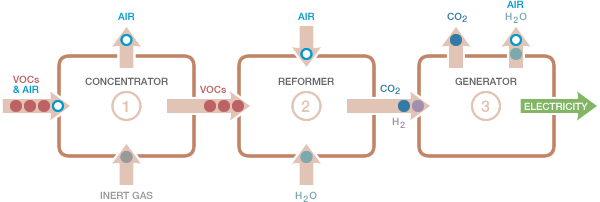Facilities-Related Emissions
We report on a variety of facilities-related emissions in the Environment data section. However, we have put particular emphasis on reducing our facility emissions of volatile organic compound (VOCs), and so discuss that topic here. For more information on greenhouse gas emissions from facilities please see Operational Energy Use and Greenhouse Gas Emissions.
Volatile Organic Compounds
Since 2000, Ford's North American operations have cut volatile organic compound emissions associated with the painting process (by far the largest source of VOC emissions) by 25 percent. In 2007, these operations emitted 24 grams of VOCs per square meter of surface coated, a reduction of 2 grams per square meter from 2006, and significantly below the target of 29 grams per square meter. Because the control equipment used to reduce VOC emissions consumes significant amounts of energy, we have worked to identify innovative approaches to painting operations that meet cost, quality and production goals while allowing us to reduce energy use significantly and maintain environmental compliance.
As one element of this approach, Ford developed an innovative "fumes-to-fuel" system in partnership with Detroit Edison. Initially tested at the Dearborn Truck Plant, the system concentrates fumes containing VOC emissions from solvent-based paint and uses them as fuel to generate electricity. The Rouge test fed the concentrated fumes into a fuel cell.

Generating electricity from paint fumes
Move over the numbers above to see what happens at each stage.
Strips air from paint fumes, leaving concentrated volatile organic compounds (VOCs)
Ford-patented process converts VOCs to hydrogen gas
Uses hydrogen gas as fuel for fuel cell or conventional power plant to make electricity
The beta-test version of fumes to fuel was installed as a pilot project at Ford's Michigan Truck Plant. The Michigan Truck system used a specially designed Stirling Cycle Engine that was more cost-effective than a fuel cell. The engine produced about 50 kilowatts of electricity to help power the facility. The only byproducts of the system, which cut electrical usage by one-third to one-half, were small amounts of water vapor, CO2 and nitrogen oxides. The Stirling Engine also produces heat during combustion, which may be another useful source of energy in the future.
We are beginning full-scale implementation of this technology, with a larger-scale version at our Oakville, Ontario, plant. This version will launch with a 120-kilowatt internal-combustion engine and migrate to a 300-kilowatt fuel cell. The Oakville system will be operational in 2008.
We are also reducing VOCs by eliminating painting entirely on some plastic parts, by using "mold-in-color" plastic technology. Mold-in-color plastics are injection molded with high-gloss metallic color already incorporated. By eliminating the need to paint some molded plastic parts, this technology has the potential to significantly reduce paint-related VOC emissions. Mold-in-color also reduces costs and improves quality. In its first implementation, it saved $10 per vehicle because there was no need to prime or paint the plastic parts after they were molded. The mold-in-color technology meets or exceeds all quality and performance requirements. For example, it performs significantly better than traditional painted parts in chipping and scratching; because the color goes all the way through the part, chips and scratches do not show. This technology was introduced on the 2008 F-250 and Super Duty wheel lip moldings. We are working on other applications, including both exterior and interior painted plastic parts.
We are also reducing VOC emissions with an innovative paint process called "three wet." This process reduces VOC emissions by 10 percent and has other environmental, financial and quality benefits. For more information on "three wet," please see the Operational Energy Use and Greenhouse Gas Emissions section.
We are further reducing the VOC emissions associated with our paint shops by using new paint processes and materials. We recently introduced a new paint "purge" process at the Kentucky Truck Plant that significantly reduces VOC emissions. For more information, please see New Paint Process Eliminates Source of VOC Emissions and Hazardous Waste at Kentucky Truck Plant.